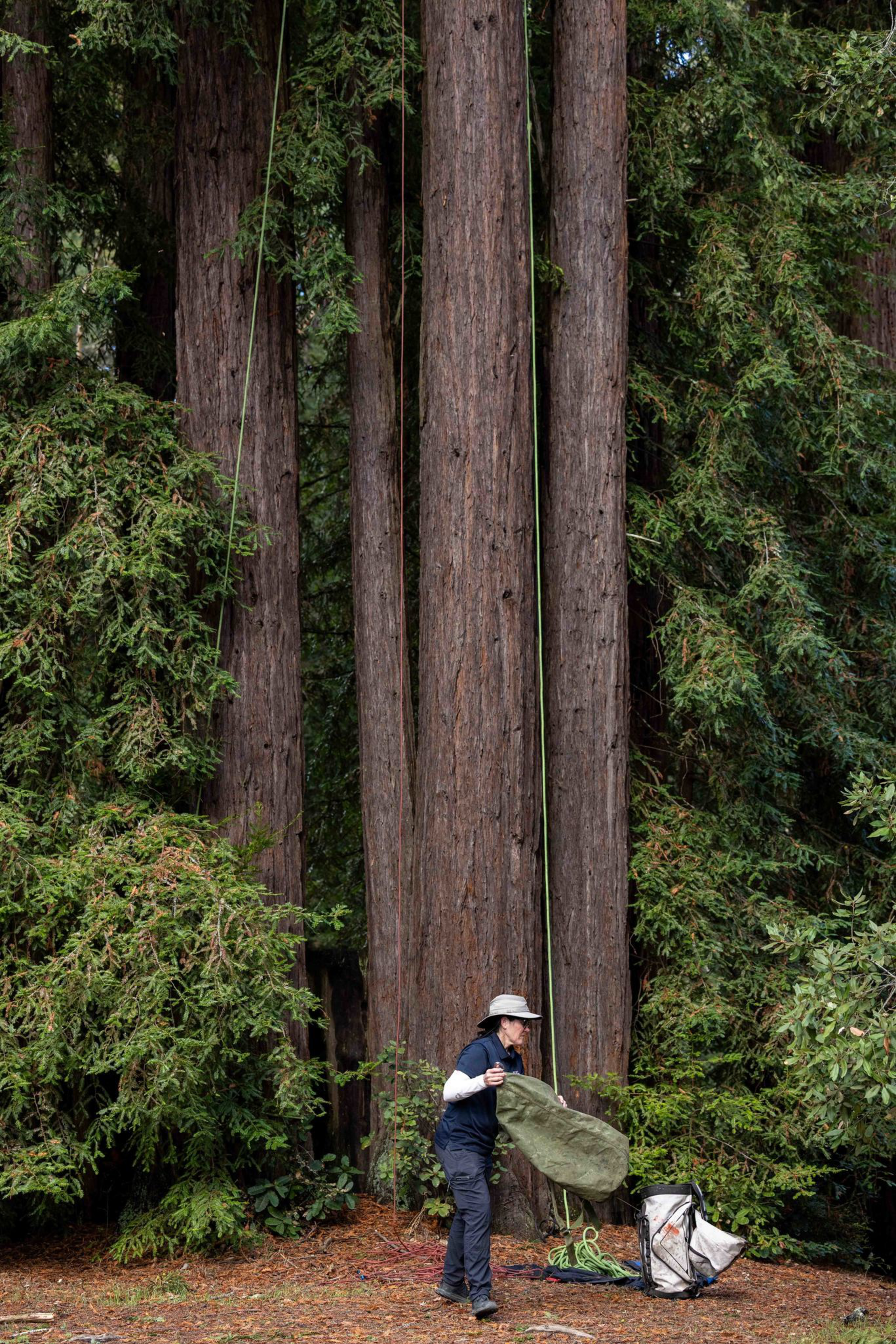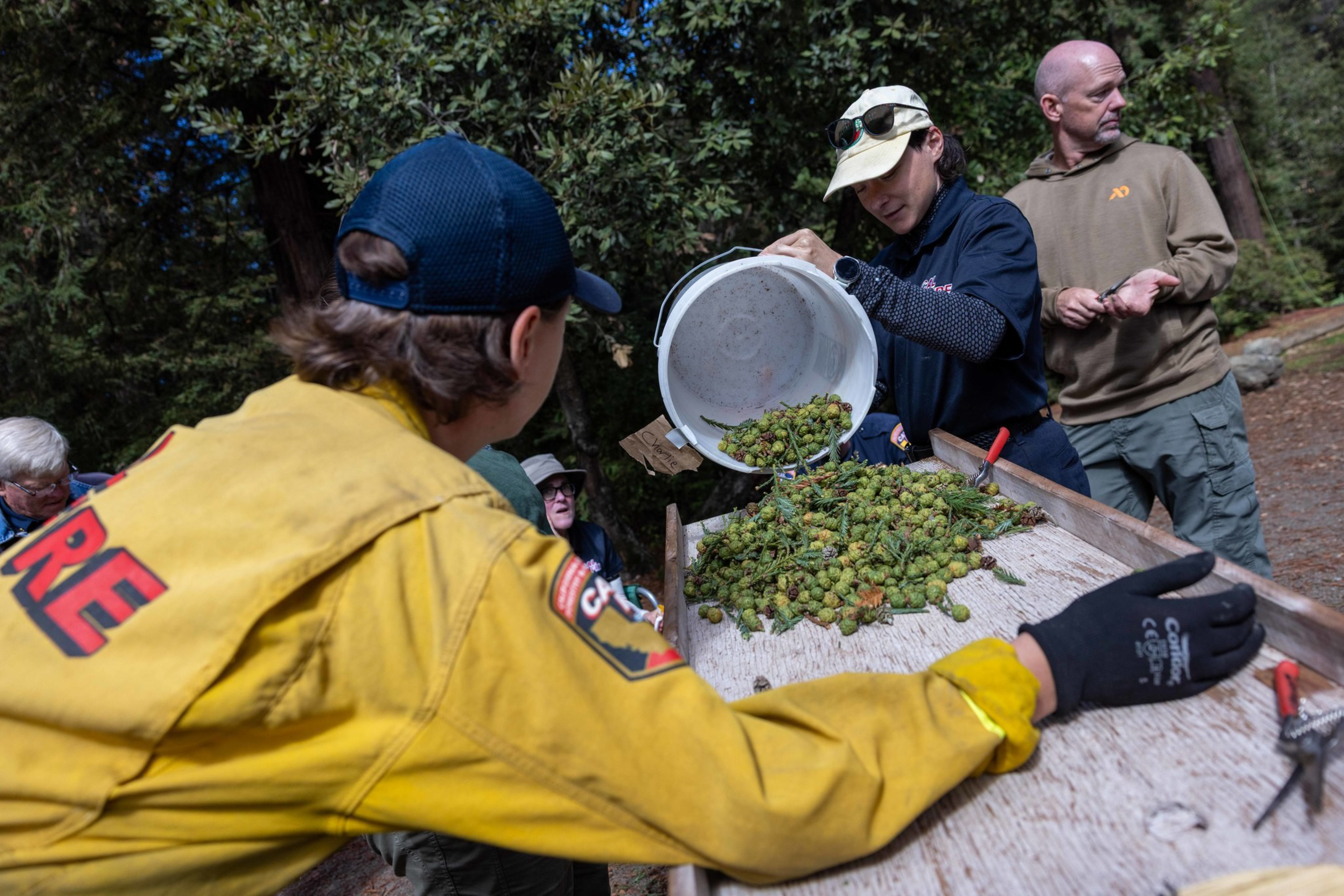Miles Ryan stood on a carpet of pine needles, looking up at the young coast redwood towering above an empty campsite at Mount Madonna County Park in the Santa Cruz Mountains. He checked his harness one last time, gave an assured look to his ground crew, and started to climb.
One hold after another, his hands and feet found notches on the trunk as it swayed in the wind and branches bent under his weight.
When he’d reached roughly 150 feet, he stopped. Rare old-growth coast redwoods can reach 300 feet or more, but this second-growth Sequoia sempervirens was a mere 175. There, balanced at the top of the forest, Ryan leaned out toward the tips of the limbs to get what he’d come for: pine cones, each the size and color of a green Castelvetrano olive.

It was one of Cal Fire’s last cone samplings of the season, which usually runs from August to October across state forests and conifer species. Each cone contains anywhere from a few dozen to hundreds of precious seeds. These have become more important in recent years, as an uptick in severe wildfires and the spread of insects and diseases have led to mass deaths of pines across California forests.
Even coast redwoods and giant sequoias, endangered natives previously thought to be largely impervious to wildfire, are at risk amid climate change and in forests loaded with dead and dying trees that can burn extra hot. Without the pine cones, there aren’t enough samples in the state’s public seed banks, saplings to grow in public nurseries, or seedlings to plant in burned-out acreage.
But there are just a few dozen professional tree climbers like Ryan trained for high-elevation seed collection in California, and only three companies that state agencies turn to for subcontracted climbers. At Mount Madonna, Ryan was the lone contract climber collecting seeds September 30. He made quick work of his trees while CalFire trainee climbers hesitantly made their way up theirs.
Cal Fire estimates that it needs to collect 55,978 bushels of pine cones across species and locales to fully stock its seed bank. That’s enough to fill about three-fourths of an Olympic-size swimming pool and to reforest 25% of nonfederal land in the state in case of massive tree loss.
But as nonprofits and public agencies expand cone collections to try to meet that lofty seed count, they’ve discovered that caring for 33 million acres of forest land isn’t just a technological and ecological problem: It’s a labor issue.


‘Not enough people’
Britta Dyer, vice president of the Resilient Forests project at the nonprofit American Forests, compares cone collection to harvesting garden tomatoes: Pick too early, and you risk an underripe, flavorless product, but wait too long and it’s overripe — or the squirrels and insects will beat you to it.
It’s the same with pinecones. The few surveyors on the ground do the best they can, but it’s hard to check on a garden growing hundreds of feet off the ground and across every elevation in all of the state’s 85 differentiated seed zones.
To get accurate data on how pine cones are developing, trained climbers must scale trees to collect samples for monitoring ahead of harvest. After scientists X-ray the cones and confirm that the seeds are mature and healthy, the climbers return to harvest the crop.
In most California forests, there are “not enough people to see if there’s a viable crop, let alone be able to coordinate the contracting to get people to climb 150 feet up in the tree,” said Dyer.
Jimi Scheid, Cal Fire’s deputy chief of reforestation services, agrees: “There’s what’s actually growing out there, what’s a collectible crop, and the ability to act on it. Even if there were healthy crops in previous years, we might not have had the manpower or the ability to survey, monitor or collect it.”
A couple of weeks after Ryan’s climb, Cal Fire officials returned to Mount Madonna with a larger group of contract climbers, staff from the Santa Cruz County Parks Department, and a few local volunteers.

Arborist Colt Langstaff was one of several climbers harvesting redwood seeds for Sierra Cone, one of the state’s few contract companies.
Langstaff grew up in the foothills of the Sierra Nevada, where his family worked in the timber industry. His childhood revolved around trees, from learning “the art of the chainsaw” to climbing high to set the lines that move logs uphill.
Thirty years later, “if it involves a tree, I do it,” he said.
In Langstaff’s two decades collecting pine cones, he has become fluent in the language of trees — the subtle differences that distinguish a knobcone from a lodgepole pine or a Douglas from a white fir.
“Each species has its own set of challenges, whether it be the climbing or the actual collecting of the cone,” he said.
The coast redwood’s cones in particular are notoriously difficult to pick.
“You have to know how to get to the tips of the limbs without destroying the seeds,” he said. The cones are tiny, “so they’re just difficult to get off the branch, to get into the bushels.”
The small scale also creates more work on the ground, with workers needed to trim the stem from each redwood cone, one by one, to prevent the spread of sudden oak death, a pathogen found across the West Coast.
Much of California’s limited capacity for cone collection has focused on conifer species found mainly in the state’s interior, which has experienced more intense wildfires than the damp coast.
“Redwoods can typically handle fire; they can typically handle drought,” explained David Cowman, director of land stewardship at the Sempervirens Fund, which owns more than 12,000 acres in the Santa Cruz Mountains. Redwoods are uniquely fire-adaptated, with their thick, tannin-rich bark; widespread root systems; and ability to resprout from the base of a burned trunk.
But after persistent drought, and the 2020 CZU Lightning Complex fires that burned more than 86,000 acres in the Santa Cruz Mountains, it may not be enough to help the coastal giants survive in a changing climate.
“What we’re seeing in the Santa Cruz Mountains is those stressors and disturbances stacking on top of one another,” Cowman said. “There’s not a huge need for replanting at this point in time, but I think the big fear is that we just don’t know what’s coming in the next 20 to 100 years.”

The green pipeline
Langstaff estimates that over his nearly two decades of professional tree-climbing across the U.S., he has collected nearly a billion conifer seeds. He’s passing on the trade to his teenage kids, who help with his tree business in Grass Valley.
Langstaff sees a bright future working in trees, even if it’s a lonely business. “You can go anywhere in the world where there’s trees, and you have the knowledge, a couple of saws, some rope, and a harness, and you can make money.”
Climbers like Langstaff are needed across the state, as seeds aren’t geographically interchangeable.
“We wouldn’t want to take seed from Humboldt County and try to grow it here in Santa Clara County,” said Topher Byrd, a statewide reforestation coordinator for Cal Fire who is based in the Santa Cruz Mountains. “The climate is just too different; the soils are different.”
October’s collection in Mount Madonna yielded just 16.5 bushels of coast redwood cones — a drop in the bucket for the state’s reforestation needs. Over the course of an entire seed season, the agency can collect as many as 5,000 bushels or as few as 200. More climbers are key to boosting the yield.

Some advocates say the dearth of climbers echoes labor shortages in other land management and conservation efforts that have an impact on forest health.
To cultivate more climbers, American Forests has partnered with Cal Fire, the U.S. Forest Service, and private landowners to build a corps of volunteers and trainees through “cone camps” that train up to 200 people each year and an apprenticeship program that has placed more than 40 in reforestation roles.
But a long-term expansion of the California workforce will require more than training and outreach — it’ll cost millions. “We’ll be looking for additional funding to keep it going in order to make sure that we didn’t just start a conversation about workforce, but that we can actually sustain it,” said Dyer.
As for the biggest barriers for new professional tree climbers, Ryan points to a simple explanation: fear of heights. Even for passionate rock climbers, trees present a unique challenge: They sway in the wind.
But for him, it’s a quiet thrill. “It‘s not a roller coaster. It’s so gentle and sweet,” he said. “There’s so much trust up there at the top when it’s moving.”
After reaching the top of a sugar pine earlier this year, Ryan’s ground crew told him the work was done — the team had collected enough cones. Instead of coming down, he roped in at a fork near the top, rested his head against one branch, and threw his legs over another.
“It was like a hammock,” he said. And slowly, up in the tree tops, Ryan let the wind — and his trust in the sugar pine — rock him to sleep.